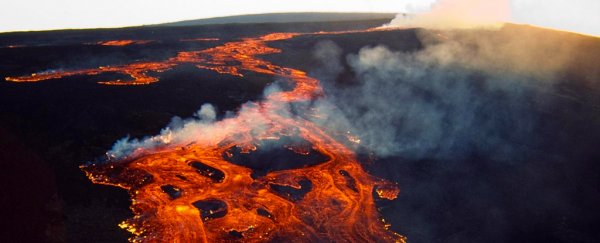
Scientists Reveal The Full Danger of The World's Largest Active Volcano
DAVID NIELD 3 AUGUST 2022Active for at least the last 700,000 years, and dominating the landscape of Hawaii, Mauna Loa is the largest shield volcano on Earth (above water, at least) – and scientific data reveals more about what might be enough to set off future eruptions.
Looking at shifts in the ground tracked by GPS and satellite data, researchers in 2021 were able to model the flow of magma on the inside of the volcano, as well as figuring out what would and wouldn't be likely to trigger the next major eruption from Mauna Loa.
In the 'would be likely' column: a sizable earthquake. That conclusion is based on measurements of magma influx that have happened since 2014, directed by the topographic stress of the surrounding rock.
"An earthquake of magnitude 6 or greater would relieve the stress imparted by the influx of magma along a sub-horizontal fault under the western flank of the volcano," said Bhuvan Varugu, a geologist at the Rosenstiel School of Marine and Atmospheric Science at the University of Miami, in a press release accompanying the 2021 study.
"This earthquake could trigger an eruption."
The scientists determined that 0.11 square kilometers (about 0.04 square miles) of new magma flowed into a new spot in the volcano chamber between 2014 and 2020, changing direction according to the pressures being placed on it.
These kinds of magma body changes haven't been measured before. Together with surface lava flows and ground shifts along the fault the volcano is sitting on, magma intrusions change the shape of the volcano – and the likelihood of it erupting.
Volcanologists already know that flank activity and eruptions are closely related at Mauna Loa, which means that changes in these flanks caused by magma injections can make a substantial difference in terms of how the volcano behaves.
"An earthquake could be a game changer," explained marine geologist Falk Amelung from the University of Miami.
"It would release gases from the magma comparable to shaking a soda bottle, generating additional pressure and buoyancy, sufficient to break the rock above the magma."
According to the data, Mauna Loa is already under a "pretty heavy" topographic load.
Further magma intrusions will increase the likelihood of an earthquake and an eruption, but it might not necessarily be needed: A lack of movement under the volcano's western flank makes the researchers think this is where an earthquake might be due.
Recent eruptions emphasize just how important an early warning could be: In 1950, lava from a Mauna Loa eruption reached the coast in just three hours. The 1950 eruption and another major one in 1984 were both preceded by substantial earthquakes.
Predicting the timings of eruptions is an incredibly complex task, with a lot of variables and estimates involved – but careful magma mapping strategies like the one in this new study can provide invaluable data for future modeling.
"It is a fascinating problem," said Amelung.
"We can explain how and why the magma body changed during the past six years. We will continue observing and this will eventually lead to better models to forecast the next eruption site."
The research has been published in Scientific Reports.
An earlier version of this article was published in May 2021.


comment 0 Comments
more_vert